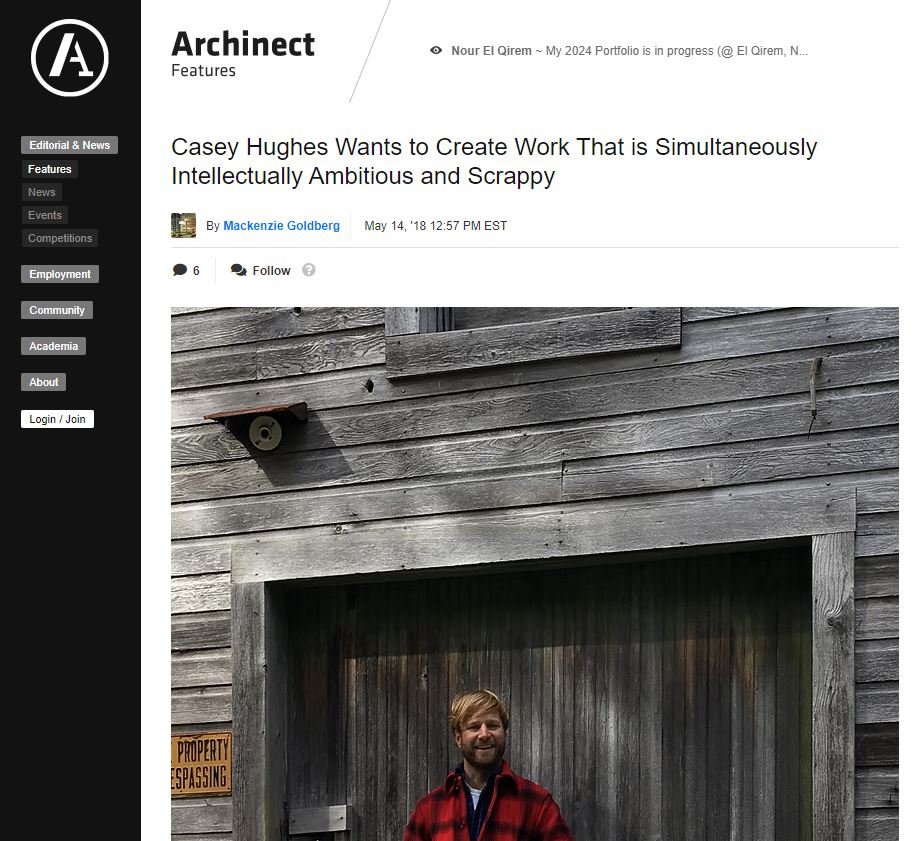Casey Hughes Wants to Create Work That is Simultaneously Intellectually Ambitious & Scrappy
Archinect Features
Casey Hughes Architects
Mackenzie Goldberg
publication:
project:
author:
Casey Hughes has made a name for himself by building into the famous hills of Los Angeles. His eponymous firm—started by his desire to push against both the academic world of architecture as well as the development-oriented one— specializes in intellectually ambitious residential projects, especially those located on some of the city's tricky hillside lots.
For this week's Small Studio Snapshot, Hughes talks about carving out a niche for himself while allowing room for design exploration.
How many people are in your practice?
Five people including Jeff Lenox, a project manager, who has been working at CHA for going on five years.
Why were you originally motivated to start your own practice?
There can be an ivory tower aspect to architecture that feels fussy and out of touch with site and construction realties. Conversely, so much development-oriented construction (and building in general!) is needlessly banal. I started CHA to push against these poles and create work that is simultaneously intellectually ambitious and scrappy.
What hurdles have you come across?
A current challenge is making the transition from thinking about the office as a collection of projects to realizing that the office is the project. Rather than predicating our work on clients, this shift allows us to design the office’s direction. Growing a practice into different project types without having that project type already in your portfolio can be tricky. I’m finding that this catch-22 can be circumvented by engaging the project types that we’re interested in and then, the clients will follow.
How do you explain your architectural ambitions to a client?
Like many architects, we’ve found clients have an easier time buying into an idea if they understand the project’s formal logic. We often create a series of sequential diagrams that explain the derivation of the building. This narrative isn’t intended to represent the steps that we went through to design the building, but rather the logic underpinning the project. This reduces the perceived subjectivity of the design and creates the context for the client to appreciate the building’s form.
Is scaling up a goal or would you like to maintain the size of your practice?
Thus far, CHA has been primarily focused on homes especially tricky hillside lots, and housing, but we’re increasingly working on projects that engage a broader community. Rather than the size, I’m interested in the capacity of our office to create architecture that has a profound impact, while remaining lean so we can continue to be selective, focusing exclusively on projects that require genuine design exploration.
How did you land in that specialty? Do you think it was advantageous for starting a practice?
Los Angeles is often thought of as a horizontal city, but ironically much of the modern residential architecture that it’s known for occurs in the hillsides. Prime examples of this are many of Lautner's works, such as the Chemosphere, and Pierre Koenig’s Stahl House, with it’s iconic cantilevered living room. The complexities of these hillside sites require structural and siting ingenuity that often leads to formal innovation. As Los Angeles continues to densify, the easy-to-build sites become increasingly scarce, creating the incentive to develop lots that were previously considered “unbuildable”. Many of Los Angeles’ more established architects pass on this type of project because they see the sites as overly constrained and a logistical “headache”. The ceding of this ground has created a niche that CHA and a handful of emerging architecture offices have grown into.
What are the benefits of having your own practice? And staying small?
There’s never a dull moment when you’re running a practice, as it require diverse skills and continual growth. Staying small has allowed us to maintain high design standards while remaining nimble. As our practice grows, responsibilities and demands naturally increase, so carving out time for design exploration and maintaining a broad vision for the office is essential.
